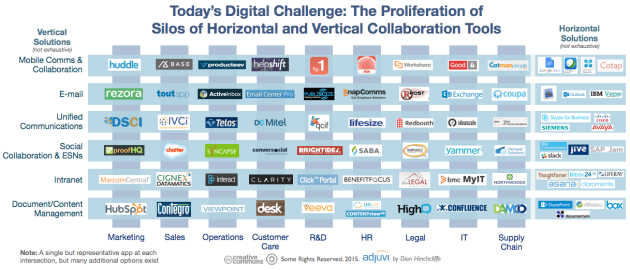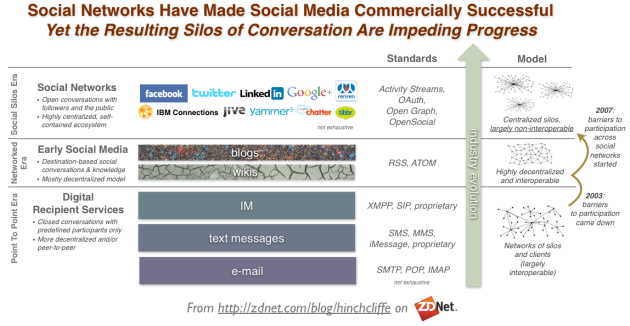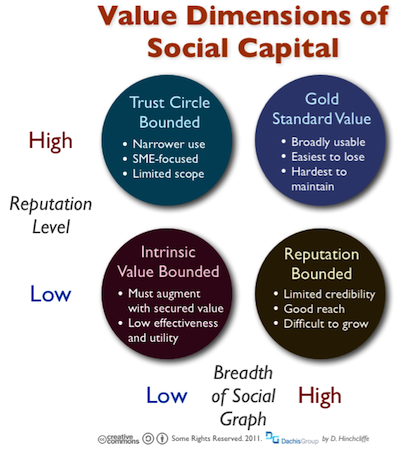How Digital Collaboration is Fragmenting, and Why It’s a Major Opportunity
June 29, 2015 5 Comments
A significant issue has been developing in digital collaboration for the last several years, and it’s now starting to become somewhat acute. I’m referring here to the pronounced trend towards app, environment, and channel fragmentation. Over the last few of years, I have been speaking with beleaguered IT managers who are struggling to cope with the sheer proliferation of software, systems, and applications that purport to help workers with collaboration. It’s not a new problem, and smart folks like Dave Winer have long worried about it, but it’s now becoming a vital strategic concern.
A variety of factors are contributing to fragmentation: Every department and function now seems to have existing vertical systems — such as their standard HR, sales, or customer care solutions — that have recently added social media, collaboration, sharing, messaging, shared content editing, document attachments, activity streams, rich user profiles, and so on to their feature sets. At the same time, many exciting new applications have emerged on the scene recently that seem nearly must-have to many of us: Dropbox, Box, Slack, even arguably IBM Verse. All of these in turn compete with the officially sanctioned collaboration applications already in the workplace currently, from e-mail and SharePoint to whatever enterprise social network and unified communications platforms have been selected under the CIO’s purview.
Some of these new collaboration applications are brought through the front door in by lines of business that feel they have special needs. Others are so-called “shadow IT” deployments by teams and departments who believe they require certain features or prefer the ease-of-use of alternative collaboration tools, but don’t want to go through the formal hassle of getting blessing. Finally, a good many come in via legacy adoption via mergers/acquisitions or through individual users using their own devices and app stores.
Note: User-driven IT itself isn’t the problem here, it’s actually a key source of opportunity if wielded properly in a network of enabled/supported change agents.
Related: What Does a Modern Collaboration Strategy Look Like?
Too Many Collaboration Tools, Not Enough Collaborative Reach
Whatever the source, this trend is creating dozens — and sometime hundreds, in large enterprises — of collaborative silos, where participants and their information are trapped, inaccessible and invisible to a broader range of potential actors. Worse, unlike the original communications tools in the industry — like e-mail — the walled garden trend that started with the great consumer social networks — largely to support business models and not to help users — has decisively shifted to enterprise collaboration software today. Thus, unless you have a license and are using the exact same app, chances are increasingly poor that you can collaborate with someone unless they are using the exact same toolkit and environment.
I’ve pointed this out in the past, the we have an urgent problem with our collaboration tools not talking to each other. I’d say it’s now a critical issue that threatens the very high-value, human-centric activity that we are supposed to be enabling: Better collaboration. In addition to the typical common issues, I can’t tell you how many times I’ve heard that users have moved away from a collaboration tool because they can’t easy work with customers, or business partners, who are usually outside the company and don’t have access to the same tools or environment.
Now the issue is not just that we have barriers, but that we have so many new applications that we are employing, very few of which are interoperable. The result is that we are creating a growing array of inaccessible bubbles of insulated collaboration within our organizations. Much of this is done in the name of achieving worthwhile goals: Accessing powerful new capabilities, modernizing our workplace tools, improving security, and/or making sure we have vendor stability. However, we’re learning that we are often creating a solution that’s potentially much worse than the problem we’re trying to solve.
One of the challenges of adopting new digital solutions for collaboration has been that they’re often championed by those for whom technology isn’t their primary background. Consequently, federated architectures, open standards-based technology, and interoperability usually aren’t high on the list of sought after features for collaboration tools by most business users. Partially as a result, growing islands of collaboration have become a very real problem today, as lack of decent connection between our collaboration tools is — instead of creating a large and growing body of collective intelligence accessible to all — is actually resulting in parochial backwaters where too few people use the tools to make them worthwhile.
Certainly, some of the latest additions to the industry pool of collaboration options — and yes, I’m talking about Slack here — are designed specifically to address this issue, as it becomes one of the largest — and most ironic — new obstacles to effective collaboration: Too many apps and channels for working, none of which share well with each other. Solutions like Slack make all the knowledge and content flowing through our many individual business applications, visible from one collaboration platform. And that’s certainly one major way to solve the problem. Certainly, approaches like OpenSocial have tried to tackle it in other ways, and now the W3C Social Web Working Group is looking at the issue as well. So perhaps we’ll still end up with an SMTP for collaboration, but we don’t have it yet.
In the past, I’ve exhorted our industry — especially the most strategic and important aspect of it, social collaboration — to stop the fragmentation and create interoperability standards. But vendors — who can only exist when there are enough customers — have little incentive to help others, nor do their users insist on it. In fact, I’ve steadily come to believe that the problem with not be solved by vendors, customers, or even standards bodies, each of which has a) corporate goals contrary to a real solution to making collaboration tools work together, b) don’t fully understand the details of collaborative systems and their management well enough, or c) can’t gain traction because of the first two issues, respectively.
A Quick Back-of-the-Envelope Proof
As a cross-check, especially since I’m seeing the flow of new collaboration applications increase rather than decrease, I took a look (results in first diagram above) at some of the top types of collaboration tools (content/document management, intranets, social collaboration tools, ESNs, unified communication platforms, e-mail, and mobile collaboration tools) and put them on another dimension against various leading corporate functions (marketing, sales, operations, customer care/support, research & development, HR, legal, IT, and supply chain), and I was able to quickly find many apps — often some just newly emerged — that could fit in each and every intersection between the two axes. This would not have been possible 2-3 years ago. In other words, everything we do is quickly becoming collaborative.
And as a result, the risk is that soon little will be, as collaboration is divided across hundreds of isolated systems that we mostly can’t see and don’t have access to internally, sharply limiting the rich results from collaboration that only open technology can uniquely provide: Working out loud, open and transparency business practices, a corporate body of knowledge, and reuse and learning from everything that the company knows, all lying searchable on the corporate network.
Related: A CIO’s Guide to the Future of Work
The Issue of Collaborative Silos Must Be Solved. And Because They Must, They Will. But When?
Instead, as the issue becomes a top one for many corporations, I now believe it’s more likely that we’ll see inclusive approaches (again like Slack and a few others like Xendo have done) that ensure these barriers don’t form, that are based on market drivers and ultimate customer value. In fact, I now see that some customers are increasingly frustrated that they can’t use their shiny new tools to work with everyone they want, or are cut-off from the communities, channels, and knowledge that they need to do their job. Fortunately, these stakeholders are the ones likely to drive the changes we need to see.
This may perhaps, at least for the smart software companies and open source projects that understand this increasingly urgent issue, be the next big opportunity for them: They must be the integrating force, the unifying center of collaboration for the enterprise, bringing all the major applications, systems, and data pools together — and make it easy for IT or others to bring in their own local apps — so that we no longer have such highly ironic digital isolation.
I fully realize this issue is not one that people can get as passionate about as the main topic of contemporary collaboration. But unless we fully understand what kind of results we are really creating, we’re going to be building as many walls and barriers as we are new modes and venues of digital collaboration. If we want, we can greatly accelerate a new and better way, a more unified way, and push for interoperability that’s as good or better than e-mail has, then truly create the collaborative worlds of our dreams.
Finally, it’s not up to someone else to make sure this takes place. It’s up to us.
Additional Reading:
The digital collaboration industry continues to flourish
Watching digital collaboration evolve: Key events in the last year












 Social networking applications. Sometimes viewed as an extension of the Web widget model, social networking applications are applications designed to run inside of popular social networking environments and usually have capabilities that tap into and make use of the
Social networking applications. Sometimes viewed as an extension of the Web widget model, social networking applications are applications designed to run inside of popular social networking environments and usually have capabilities that tap into and make use of the  Unless you've been hiding under a rock lately, you know that Facebook is presently the industry darling in social networking, having largely pushed MySpace off the industry's stage, as it seems to offer a more compelling model for social interaction to users overall. Just as importantly, Facebook also lets any other company that wants to join in party do so by building 3rd party
Unless you've been hiding under a rock lately, you know that Facebook is presently the industry darling in social networking, having largely pushed MySpace off the industry's stage, as it seems to offer a more compelling model for social interaction to users overall. Just as importantly, Facebook also lets any other company that wants to join in party do so by building 3rd party 



























































